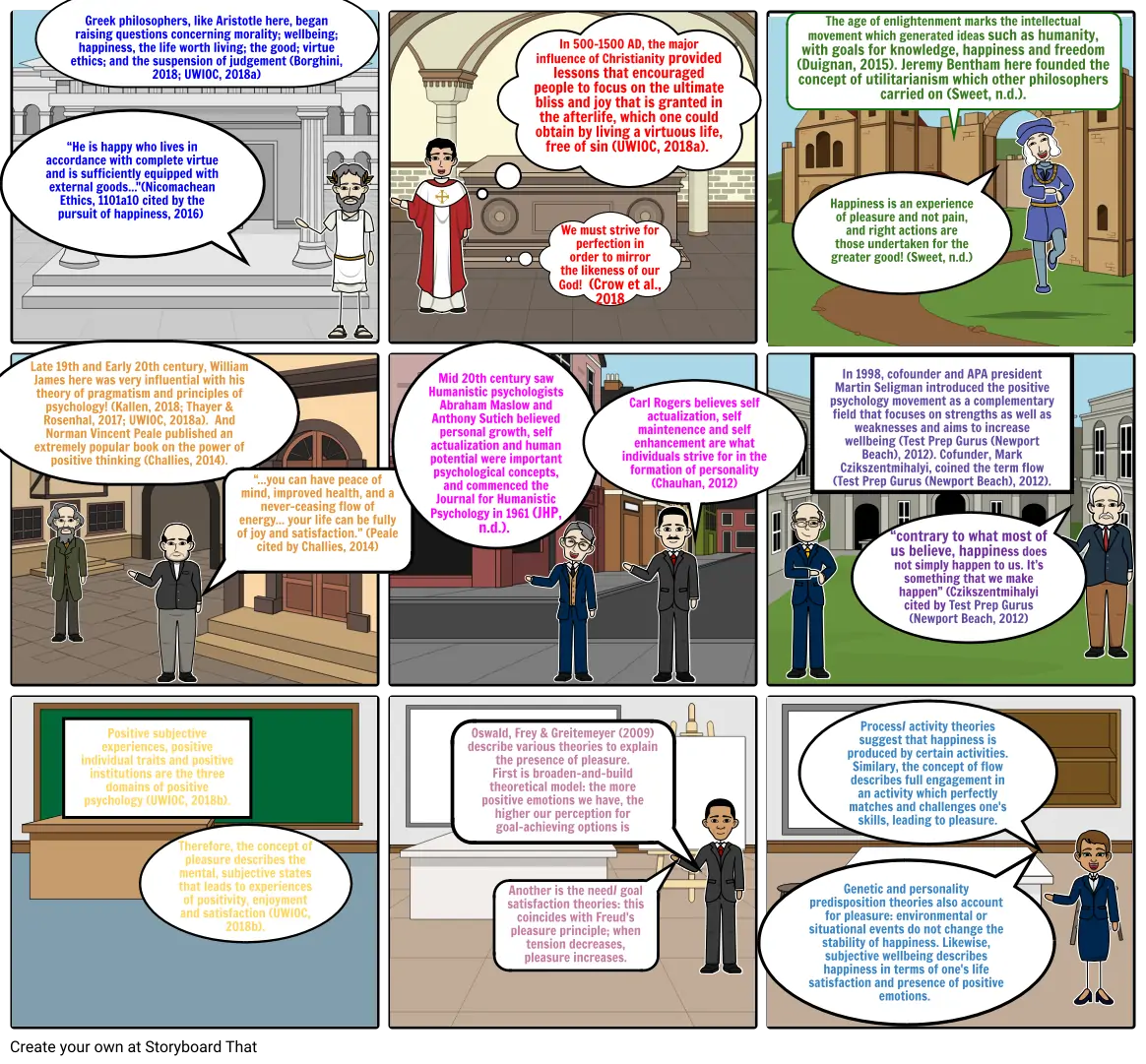Historical timeline of positive psychology

Storyboard Text
- Late 19th and Early 20th century, William James here was very influential with his theory of pragmatism and principles of psychology! (Kallen, 2018; Thayer & Rosenhal, 2017; UWIOC, 2018a). And Norman Vincent Peale published an extremely popular book on the power of positive thinking (Challies, 2014).
- “He is happy who lives in accordance with complete virtue and is sufficiently equipped with external goods..."(Nicomachean Ethics, 1101a10 cited by the pursuit of happiness, 2016)
- Greek philosophers, like Aristotle here, began raising questions concerning morality; wellbeing; happiness, the life worth living; the good; virtue ethics; and the suspension of judgement (Borghini, 2018; UWIOC, 2018a)
- Mid 20th century saw Humanistic psychologists Abraham Maslow and Anthony Sutich believed personal growth, self actualization and human potential were important psychological concepts, and commenced the Journal for Humanistic Psychology in 1961 (JHP, n.d.).
- In 500-1500 AD, the major influence of Christianity provided lessons that encouraged people to focus on the ultimate bliss and joy that is granted in the afterlife, which one could obtain by living a virtuous life, free of sin (UWIOC, 2018a).
- We must strive for perfection in order to mirror the likeness of our God! (Crow et al., 2018
- The age of enlightenment marks the intellectual movement which generated ideas such as humanity, with goals for knowledge, happiness and freedom (Duignan, 2015). Jeremy Bentham here founded the concept of utilitarianism which other philosophers carried on (Sweet, n.d.).
- Happiness is an experience of pleasure and not pain, and right actions are those undertaken for the greater good! (Sweet, n.d.)
- “...you can have peace of mind, improved health, and a never-ceasing flow of energy... your life can be fully of joy and satisfaction.” (Peale cited by Challies, 2014)
- Carl Rogers believes self actualization, self maintenence and self enhancement are what individuals strive for in the formation of personality (Chauhan, 2012)
- In 1998, cofounder and APA president Martin Seligman introduced the positive psychology movement as a complementary field that focuses on strengths as well as weaknesses and aims to increase wellbeing (Test Prep Gurus (Newport Beach), 2012). Cofunder, Mark Czikszentmihalyi, coined the term flow (Test Prep Gurus (Newport Beach), 2012).
- “contrary to what most of us believe, happiness does not simply happen to us. It’s something that we make happen” (Czikszentmihalyi cited by Test Prep Gurus (Newport Beach, 2012)
- Positive subjective experiences, positive individual traits and positive institutions are the three domains of positive psychology (UWIOC, 2018b).
- Therefore, the concept of pleasure describes the mental, subjective states that leads to experiences of positivity, enjoyment and satisfaction (UWIOC, 2018b).
- Oswald, Frey & Greitemeyer (2009) describe various theories to explain the presence of pleasure. First is broaden-and-build theoretical model: the more positive emotions we have, the higher our perception for goal-achieving options is
- Another is the need/ goal satisfaction theories: this coincides with Freud's pleasure principle; when tension decreases, pleasure increases.
- Genetic and personality predisposition theories also account for pleasure: environmental or situational events do not change the stability of happiness. Likewise, subjective wellbeing describes happiness in terms of one's life satisfaction and presence of positive emotions.
- Process/ activity theories suggest that happiness is produced by certain activities. Similary, the concept of flow describes full engagement in an activity which perfectly matches and challenges one's skills, leading to pleasure.
Vytvořeno více než 30 milionů Storyboardů

